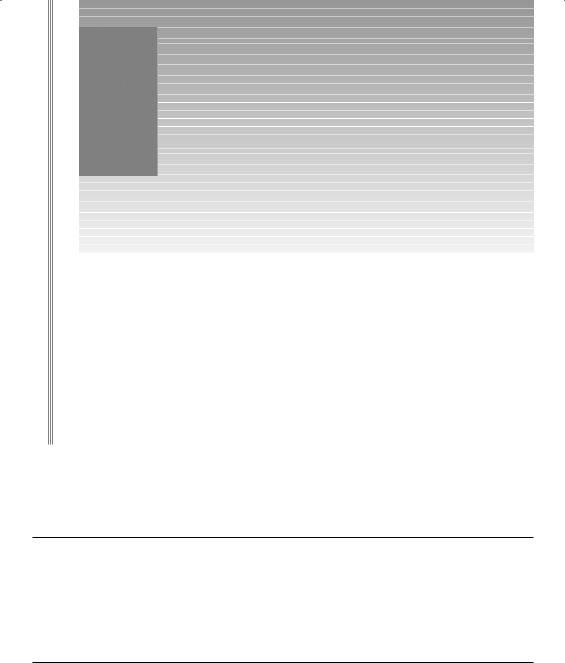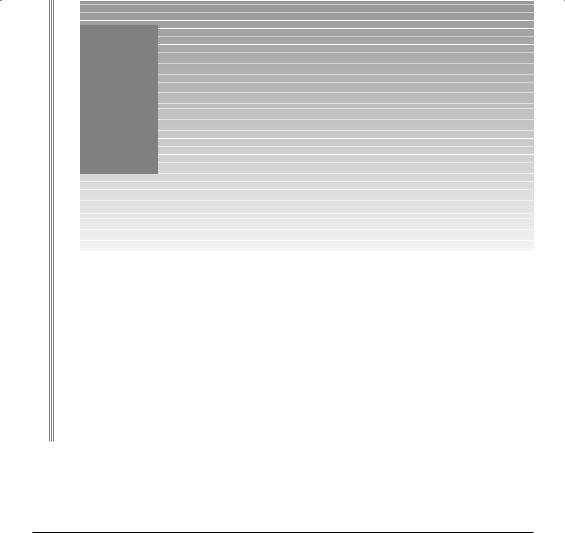
Cagle R.B. - Blueprint for Project Recovery[c] A Project Management Guide (2003)(en)
.pdf
S E L E C T I N G T H E B E S T O F T H E B E S T |
185 |
expensive today and profit and schedule sensitivities are critical. Second, software is now available to be used independently or in conjunction with other software that makes the job of planning much simpler and faster, not to mention more accurate.
The concept of the Monte Carlo technique is to assign Probability Density Functions (PDFs) to outcomes. For example: Assume you have established a task that is thirty days in duration. What is the probability that the task will be four days late? What is the probability that the task will be done on time? What is the probability that the task will be accomplished four days ahead of schedule? The probability figure is the traditional 0–1 where 1 is the equivalent of 100 percent. Note that each of the figures is independent and the sum of all the figures do not add up to one. Now, you don’t have to run too many projects or programs to realize that, in the real world, the probability of schedule occur-
These are the PDFs that you Mrun. It’s clear that, even with all the objectivity of the computer and its processes, the basic data is subjective. In other words,
rence grows with time. In other words, the later the estimate, the more likely it |
|
|
Y |
is that the task will be completed. If the original estimate is anywhere near |
|
L |
|
correct, you will get a distribution that looks something like: |
|
F |
|
4 days |
.1 |
0 days |
.7 |
A |
.9 |
4 days |
|
E |
|
T |
|
you established the original thirty days and you established the PDFs that apply to each of the variances. hat selection was, at least to some degree, subjective.
The computer will now select some random numbers and run the probabilities over and over. You will end up with a high probability that the task will be completed near the originally scheduled date but will be skewed slightly forward. The early/late probabilities will center on this highest probability and create a traditional bell curve or standard distribution curve. This foregoing has been an extremely simplified example of what you might encounter in the field.
As promised at the outset of this book, I will not go into the math involved in this process. If you are interested, I suggest you get a copy of any of the books dealing with the Monte Carlo method. There are many, many of them out there. You might consider the following books:
Rubenstein, Reuven Y. Simulation and the Monte Carlo Method. New York: John Wiley, 1981.

186 |
B L U E P R I N T F O R P R O J E C T R E C O V E R Y |
Fishman, George S. Monte Carlo. New York: Springer-Verlag, 1996.
Sobol, Ilya M. A Primer for the Monte Carlo Method. Boca Raton: CRC Press, 1994.
Software, compatible with Microsoft products to provide Monte Carlo Simulation, is available as ‘‘@RISK for Project’’ from:
Technology Associates
The Mansley Centre
Stratford-upon-Avon
Warwickshire CV37 9NQ
U.K.
Worldwide Sales Office:
Phone: 44 (0) 1789 297000
Fax 44 (0) 1789 292191
E-mail: info@techassoc.com
U.S. Office
Phone: 917-210-8120
Fax: 917-210-8182
Voice mail: 206-374-2154
8.3Eliminating Holes and Overlaps
Holes exist when a requirement or issue is uncovered. Overlaps exist when requirements or issues are covered more than once, either totally or partially. The point in determining holes and overlaps is to make our processes more efficient by covering all the requirements or issues without unnecessary redundancy. One problem that overlaps will exhibit, if they are allowed to remain in the system, is to provide multiple answers to the same problem. If, in future, a change is necessary, it is possible that only one of the approaches will be changed, thereby leaving different answers to the same issue in the system. That creates, rather than solves, a problem.
Once all the approaches have been identified, they should be laid side-by- side, so to speak, and carefully analyzed for holes and overlaps. The best way to accomplish this task is to create yet another matrix with the requirement or issue across the top and the approaches up the side. Holes will be manifest by the lack of an intersect between a requirement or issue and an approach. Overlaps will be manifest by the existence of more than one intersect with a requirement or issue.

S E L E C T I N G T H E B E S T O F T H E B E S T |
187 |
You should understand that it is possible that one approach can be used to resolve more than one requirement or issue, as in Approach A in Table 8-3. However, two approaches to the same requirement or issue create an overlap, as in Requirement 3.
T a b l e 8 - 3 — A n a l y z i n g H o l e s a n d O v e r l a p s
|
Requirement 1 |
Requirement 2 |
Requirement 3 |
|
Approach A |
X |
|
X |
|
Approach B |
|
X |
|
|
Approach C |
|
|
|
Hole |
Approach D |
|
|
X |
|
|
|
|
Overlap |
|
8.4Choosing the Causes
You should now have a pretty clear idea of the requirements and the answers. Looking at the matrix you just created should show which approaches to choose and where you have more work to do. You will want to choose approaches that give you the most ‘‘bang for the buck.’’ As you continue to review the approaches, you may well want to combine the best of them into a single approach that applies to the greatest number of problems. As you read through the book and the Attachments, you will find that some approaches or forms or techniques apply to a great number of requirements or issues. The Requirements Traceability Matrix (RTM), presented in Chapter 1 and Attachment 7, is one such approach that is applied to many issues. Use this same applicability as you choose your causes.
Notes
1.Jay Arthur
2244 S. Olive St. Denver, CO 80224 Phone: 888-468-1537 303-756-9144
E-mail: jay@qimacros.com

C H A P T E R 9
IMPLEMENTING THE
TAILORED CHANGES
9.1General
This chapter presents three diverse techniques for implementing new Cause Descriptions and a process to assist you in selecting the technique or techniques you will use.
9.2Implementation Techniques
There are undoubtedly many techniques you can use to implement these new causes you have developed. Naturally, you are free to use your own. I show three techniques in this chapter that will help greatly. In fact, I have already made accommodation in the existing Search Tables for two of the techniques.
First, you will find blanks in the Search Tables provided so that you can ‘‘slip
188

I M P L E M E N T I N G T H E T A I L O R E D C H A N G E S |
189 |
in fixes’’ with subalphas that start where the filled-in Search Table subalphas leave off. When you review the Search Tables, you will find that each ‘‘family of causes’’ can accommodate seven potential causes (a through g) even though only two or three may have been used. The unused entry lines are designed to allow you to slip in new causes that relate to that family but may be unique to your product or company. You can simply fill in the new causes as they are identified.
Second, you will find additional blanks for the Search Tables that start at the end of the filled-in Cause Descriptions. These are provided as ‘‘On-Ramps’’ to allow you to add additional ‘‘families of causes’’ you discover that are unique to your product or company.
9.2.1SLIPPING IN THE FIX
The process of ‘‘Slipping in the Fix’’ is one of putting the fix in where it belongs but not changing the basic ordering technique. This will put the fixes in approximately the right place for future use. Space has been left in the basic tables for you to make these entries. These rows have been left uncoded so you can type your entries directly into the tables. A representation of this technique is shown in Table 9-1.
T a b l e 9 - 1 — S p a c e s f o r ‘ ‘ S l i p p i n g i n t h e F i x ’ ’
3 |
POLICIES, PLANS & PROCESSES |
|
|
|
|
|
|
|
|||
3a |
There is a clear trail between standard policies, plans, and program/project |
Expand |
No |
Yes |
|
|
technical plans |
|
|
|
|
|
|
|
|
|
|
3b |
There is a clear trail between customer policies and the program/project |
Expand |
No |
Yes |
|
|
and technical plans |
|
|
|
|
|
|
|
|
|
|
3c |
There is a clear trail between enterprise policies and the program/project |
Expand |
No |
Yes |
|
|
and technical plans |
|
|
|
|
|
|
|
|
|
|
|
|
|
Expand |
No |
Yes |
|
|
|
|
|
|
|
|
|
Expand |
No |
Yes |
|
|
|
|
|
|
|
|
|
Expand |
No |
Yes |
9.2.2CREATING ‘‘ON-RAMPS’’
The process of creating On-Ramps is a part of the planning process. When you are modifying the Search Tables and Cause Descriptions for your own use, simply accommodate changes that are sure to come. On-Ramps have been cre-

190 |
B L U E P R I N T F O R P R O J E C T R E C O V E R Y |
ated for your data entry within the compact disk (CD) that accompanies this book. A representation of this technique is shown in Table 9-2.
The blank lines in the tables have been left uncoded so you can type your entries directly into the tables. The links however are coded and will work the same as they do in the provided tables.
T a b l e 9 - 2 — S p a c e s f o r ‘ ‘ O n - R a m p s ’ ’
TECHNICAL SEARCH TABLES (ADDED)
70 |
|
|
|
|
|
|
|
|
|
70a |
|
Expand |
No |
Yes |
|
|
|
|
|
70b |
|
Expand |
No |
Yes |
|
|
|
|
|
70c |
|
Expand |
No |
Yes |
|
|
|
|
|
70d |
|
Expand |
No |
Yes |
|
|
|
|
|
70e |
|
Expand |
No |
Yes |
|
|
|
|
|
70f |
|
Expand |
No |
Yes |
|
|
|
|
|
70g |
|
Expand |
No |
Yes |
|
|
|
|
|
9.2.3‘‘DUMPING’’ THE FIX
The process of ‘‘Dumping’’ the fix is simply a matter of dumping in the fix whenever it is discovered. This is a ‘‘quick and dirty’’ method of getting the job done and may be what you need because of time constraints. My suggestion is that you go back later and clean up the result of this technique by better organizing its incorporation when you have time.
9.3Selecting Your Technique
The selection of your technique will probably be controlled by two things: the time available and your personality. If you have the time available, meaning you are in the Planning Phase, and if your personality is one of organization, you will probably use the technique of ‘‘Creating On-Ramps.’’ If you are in the middle of your program and pressed for time but you have an organized personality, you will probably choose the technique of ‘‘Slipping in the Fix.’’ If you are up to your hips in alligators and just want to get the job done and get on to the next issue, you will probably use the ‘‘Dumping’’ technique. Personally, I prefer the ‘‘On-Ramp’’ technique but I have ‘‘been there, done that’’ and have had to use the other techniques at times.

C H A P T E R 1 0
CONCLUDING
10.1General
As a project manager, you probably consider yourself through. After all, you found the problem, created a fix, invented new metrics, and incorporated the whole thing into your project that is now operating as it should. You’ve done your part so you’re through, right? Wrong! Now is the time to follow through. Even though the program or project is temporary, by definition it has a beginning and an end, and you have a responsibility to the continuum, the enterprise. It was the enterprise that created the project or program in the first place, and it will be the enterprise that prevails after the project or program is completed.
Every company operates a little differently so you’ll need to make your involvement consistent with how your company does business. Whatever it is, the findings you came up with must be incorporated back into how the company, the enterprise, the program, and the project do business. The ‘‘thing’’ that
191

192 |
B L U E P R I N T F O R P R O J E C T R E C O V E R Y |
created the problem in the first place must be corrected. If you followed all the steps in this plan, you should know what the ‘‘thing’’ is. Now the issue is how to fix it.
10.2The Concluding Process
Now that you have been through finding the causes of problems and expanding the cause base, you are in good position to carry the concept to the entire enterprise. Now is the time to gather together all the project managers, the quality manager, and the training manager and apply all this to the entire enterprise. It could well be that your enterprise wants you to continue with your project essentially unencumbered. After all, that’s your primary task. In this case, hand off the findings to the person designated by the enterprise for followup. If you are an executive above the project level, ensure that the responsible project manager is involved in the conclusion process.
10.2.1QUANTUM IMPROVEMENT
The principal thesis of Quantum Improvement (QI) is really just an extension of the 80/20 Rule by compounding the multipliers. Fundamentally, QI assumes that the top 20 percent of the 80/20 Rule is nonlinear and projects that one percent of the problems cost (or return) 50 percent of the money. What you want to do in this part of the process is to ensure that at least the most important findings are incorporated into the ongoing process.
Remember how the 85:15 Rule and the Pareto Principle and the Monte Carlo Simulation technique work? What was common to all of them? That just a few problems cause the most trouble or cost the most money, or both. That’s the idea behind Quantum Improvement: To make a quantum leap with a minimum of effort.
This is the perfect place to implement or reimplement the concept of benchmarking. Pull together the benchmarks that represent your competition and evaluate your position with regard to them. Use Quantum Improvement techniques to select the best of the best of the best and make startling improvements.
There are many processes available that claim to do all things for all people: Total Quality Management (TQM), Total Quality Leadership (TQL), Quantum Improvement (QI), Quantum Process Improvement (QPI), Reengineering, Six Sigma, Business Process Redesign (BPR), Business Process Improvement (BPI)

C O N C L U D I N G |
193 |
and a host of others. The truth is that each has something to offer but none is a panacea.
I can’t recommend a company or consultant to perform this task for you. You need to do your own analysis based on your own needs. I do suggest you use a consultant or company that doesn’t promise to solve all your problems. Your improvement process should be accomplished in stages. Until now, I have recommended using some technique, such as Pareto Analysis, that gives the greatest result first. Now however, you are dealing with people, with management, with employees. The approach in this instance is to attack the ‘‘lowest hanging fruit’’ first, so long as they represent important issues, and then evaluate the results. Early successes are important motivators to continue the effort. To try to change the entire culture of the enterprise is a sure path to failure.
Don’t leave it all behind just because you made a breakthrough. Institute a program of ‘‘continuous improvement,’’ but give it the resources that it will return to you. In other words, make your Continuing Improvement Process a series of Quantum Improvements. Above all, don’t try to do it all at once.
Whatever process you choose, use a facilitator. Someone who is trained in facilitating and someone without ‘‘a dog in the fight.’’ That is, someone who is independent and objective.
Back to the 85:15 Rule again. It says that 85 percent of the problems come from the processes (meaning documentation) and only 15 percent of the problems come from people. That rather suggests that you attack your documentation system first, doesn’t it? Not only does that follow the 85:15 Rule but you can do it offline without involving the operating troops and thereby reducing efficiency.
10.2.2DOCUMENTATION
Your documentation drives the actions of all the people in your corporation, company, enterprise, and project or program. If your documentation is incorrect, your process and actions are going to be incorrect. If your people are operating outside the established, documented policies, processes, and procedures, you’ve got a real problem.
If you are a medium or large company, you probably have a number of documents that drive your processes. In fact, the number of policies, processes, and procedures that exist in a company are usually a function of the size of the company. It follows then that if you are a small company, you have few, if any, policies, processes, and procedures. All that is understandable.
If you are part of an enterprise that deals in projects or programs, you must

194 |
B L U E P R I N T F O R P R O J E C T R E C O V E R Y |
have more than just a few people in your company. To fit that profile, you must have executives, staff, and operations and that means you need centralized documentation, and that usually means a library. A library can take several forms. It can be a box of books, an organized place for filing documents, or a computer. The documents can be your own or they can be imported from other sources. Additionally, the documents can be hard—meaning books—or soft—meaning in a computer somewhere. Most likely, they are a combination of both.
When considering a library, consider the order of the documents shown in Figure 10-1. The order is important, particularly on the high end. If you are a very small company, you will have your own priorities. You will probably start at the Processes level or even the Reference Documents Level. The Policy level isn’t particularly important because the guy who establishes policy is standing next to you. Normally, however, in a medium or large company, you need policies before you need processes, plans, and procedures. Reference documents and specifications will be a matter of doing business.
Let’s assume that you are a medium or large company and already have a traditional library. It will be a huge step in the right direction to have all (or at least part) of that documentation in digital form. That form allows easy updating and follows the first rule of modern documentation: ‘‘Don’t create, cut and paste.’’ It allows the supervisor on the floor to have a copy of financial policies as well as copies of current work orders stored in the computer. It also allows you to control the documentation by ensuring a single master copy that is referenced by all users.
Figure 10-2 presents a schematic of an electronic library. The cylinder in the center is the central computer of the database that contains all the digitized documentation data. As you can see, that data is available to all personnel with computer access. In today’s world, that usually means everybody. Further, all
F i g u r e 1 0 - 1 — A T y p i c a l T r a d i t i o n a l L i b r a r y
|
Policies |
|
Processes |
|
Plans |
|
Procedures |
|
Forms |
|
Ref. Docs |
|
Specifications |
|
Other |
|
|
|
|
|
|
|
|
|
|
|
|
|
|
|
|
|
|
|
|
|
|
|
|
|
|
|
|
|
|
|
|
|
|
|
